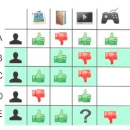Learning vector representations (aka. embeddings) of users and items lies at the core of modern recommender systems. Ranging from early matrix factorization to recently emerged deep learning based methods, existing efforts typically obtain a user's (or an item's) embedding by mapping from pre-existing features that describe the user (or the item), such as ID and attributes. We argue that an inherent drawback of such methods is that, the collaborative signal, which is latent in user-item interactions, is not encoded in the embedding process. As such, the resultant embeddings may not be sufficient to capture the collaborative filtering effect. In this work, we propose to integrate the user-item interactions --- more specifically the bipartite graph structure --- into the embedding process. We develop a new recommendation framework Neural Graph Collaborative Filtering (NGCF), which exploits the user-item graph structure by propagating embeddings on it. This leads to the expressive modeling of high-order connectivity in user-item graph, effectively injecting the collaborative signal into the embedding process in an explicit manner. We conduct extensive experiments on three public benchmarks, demonstrating significant improvements over several state-of-the-art models like HOP-Rec and Collaborative Memory Network. Further analysis verifies the importance of embedding propagation for learning better user and item representations, justifying the rationality and effectiveness of NGCF. Codes are available at https://github.com/xiangwang1223/neural_graph_collaborative_filtering.
翻译:用户和物品的学习矢量表达(包括嵌入)是现代推荐系统的核心。从早期矩阵要素化到最近出现的深层次学习方法,现有努力通常会从描述用户(或项目)的原有特征(如身份和属性)的绘图中获得用户(或项目)嵌入的用户(或项目),我们争辩说,这些方法的一个固有缺点是,在嵌入过程中,潜含在用户-项目互动中的协作信号没有被编码。因此,由此产生的嵌入可能不足以捕捉协作过滤效应。在这项工作中,我们提议将用户-项目互动 -- -- 更具体地说是双面图结构 -- -- 纳入嵌入进程。我们开发了新的建议框架 Neor图形合作过滤(NGCF),利用用户-项目图结构,在嵌入过程中潜入潜入了用户-项目。这导致用户-目录图显示高端连接模式,将合作信号有效注入嵌入嵌入进程。我们提议将用户-项目互动 -- -- 更具体的双面图结构结构结构 -- -- 进行广泛的实验,以更清晰的版本格式化模型的形式展示。




